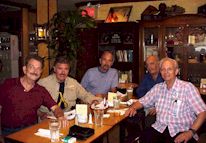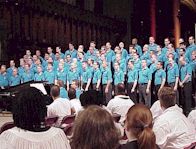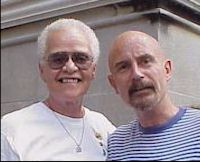 |

 30 Years Later: Celebrating the Stonewall Uprising On-the-Spot Reporting by GayToday's Editor |
|
By Jack Nichols A Personal Account
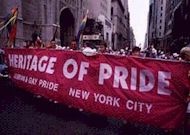 The Borough of Manhattan, New York-- June 27--- When a Florida friend from long ago begged me to fly to Manhattan for the Stonewall uprising's 30th anniversary celebration, it took me by surprise. But what better place could there be, I thought, quickly telephoning GayToday's pioneering champ, the first openly gay male on radio and TV and now the Grand High Clone Himself, Randy.
The Borough of Manhattan, New York-- June 27--- When a Florida friend from long ago begged me to fly to Manhattan for the Stonewall uprising's 30th anniversary celebration, it took me by surprise. But what better place could there be, I thought, quickly telephoning GayToday's pioneering champ, the first openly gay male on radio and TV and now the Grand High Clone Himself, Randy.
Randolfe Wicker's Greenwich Village art deco antique light store, Uplift (bargain heaven @ 506 Hudson Street) would serve us as a superb Manhattan base, I figured, while Randy himself—my gad-flying-est friend since '63—welcomed my Florida friend and me into his 'always a trip' home. Riding into Manhattan with co-passengers, spontaneous New York late-Friday-afternoon friendliness bared itself as if especially for out-of-towners. Crossing the Tri-borough Bridge we chatted animatedly with a smiling group. "See," I later whispered to my friend, "See? New Yorkers are friendly."
My friendship with Randy Wicker had developed since our early exploits (his in New York, mine in Washington, D.C.) had predated the Stonewall rebellion by a decade and it had developed further when he moved nearby but turned his spacious East Village digs to Lige Clarke and me in 1969, only a few months before Stonewall erupted.
The homosexual revolution is only part of a larger revolution sweeping through all segments of society. We hope that "Gay Power" will not become a call for separation, but for sexual integration, and that the young activists will read, study, and make themselves acquainted with all of the facts which will help them to carry the sexual revolt triumphantly into the councils of the U.S. government, into the anti-homosexual churches, into the offices of anti-homosexual psychiatrists, into the city government, and into the state legislatures which make our manner of lovemaking a crime. It is time to push the homosexual revolution to its logical conclusion. We must crush tyranny wherever it exists and join forces with those who would assist in the utter destruction of the puritanical, repressive, anti-sexual Establishment. In the wake of Stonewall, Lige and I went to the early meetings of the Gay Liberation Front. Long-time activists, we were, as gay journalists, mainly observers. There, militants Arthur Evans, Marty Robinson, Jim Owles and Arthur Bell—among the men—as well as Kay Tobin Lahusen (a pioneering militant whose lover, Barbara Gittings edited the first movement magazine for lesbians, The Ladder) all soon leapt from the GLF ship and founded the more effectively gay-issue-focussed Gay Activists Alliance. GAA emerged on the Manhattan scene at about the same time that Lige Clarke and I had became co-editors of GAY, America's first gay weekly newspaper. The revolutionary spirit of those countercultural Stonewall times struck deep in almost every New York heart. The GAA had opened its headquarters in a magnificent abandoned Firehouse in lower Manhattan. There, its savvy leaders threw the greatest, freest dances the city had ever seen. It was a loving, colorful era that was bidding happy goodbyes to the conservative strictures of the past. Though many of those same strictures would re-manifest in another generation, there was a somewhat brief utopian time, nevertheless, when folks seemed truly happy to be alive. Even so, the Stonewall era was leaving an indelible mark that, we knew then, could never be erased. In the ensuing years many established institutions would, one by one, admit they'd had no defensible basis on which to justify their anti-gay biases. Each decade I'd celebrated as one bastion of prejudice after another changed tunes. Friday night the Mother's March Against AIDS took place. Behind Randy Wicker and Sylvia Rivera, both carrying a heavy wreath, I marched in a candlelight parade down Christopher Street. Police cleared the way while Randy and Sylvia heaved the memory wreath into the Hudson while the Lavender Light: The Black and People of All Colors Lesbian and Gay Gospel Choir sang a soul-stirring version of We Shall Overcome that brought tears to my eyes.
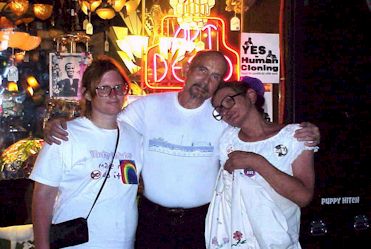
Sylvia Rivera (right) Jack Nichols and Sylvia's love, Julia The next morning, Saturday, we woke early and took the subway to 110th Street, walking thence to the Cathedral of St. John the Divine, the largest Gothic structure in existence. It was here we met up with other pioneering comrades—friends often in my daily thoughts—and also with two top notch historians. Seated in the audience, as I'd hoped he would be, was Donn Teal, the first historian to accurately capture the Stonewall era. Teal's detailed 1971 account, The Gay Militants, had been first published by Stein and Day and it remains the only complete and authentic accounting of gay and lesbian movement activity that followed directly on the heels of the 1969 uprising. The next year, Kay Tobin and Randy Wicker's The Gay Crusaders, composed of fifteen interviews with the Movement's leading pioneers, was published. Teal listened politely to spotty historical material given to two capable readers who, from the pulpit, were covering a "Time Line" between 1969-1976. Too modest about his own accomplishments-- Teal told me later what I knew as well as he, that there'd been glaring omissions in the Stonewall era Cathedral Time Line reading that had caused it, he said, to be "badly askew". "There'd been a real failure to mention," within the proper contexts, he insisted, "the real work-horses of gay liberation in those times, namely the Gay Activists Alliance. The well-meaning history readers at St. John the Divine had unintentionally overplayed the scattered contributions of the New York Gay Liberation Front," he stated, "mostly because of faulty accounts published a quarter century later by such poorly-informed historians as Martin Duberman." Teal lamented too how GAY had been ignored in both the readers' and Duberman's accountings, and yet it had been the first gay weekly newspaper. GAY may have been ignored here in the church, I laughed in reply, but its contributions were generously enshrined in your indelible history. Nor have other recent histories like The Gay Metropolis, Unspeakable: The Rise of the Gay and Lesbian Press in America, Lonely Hunters, Straight News and the Other Side of Silence forgotten to credit it. Donn Teal is a pioneer himself, not only as an historian, but as a balanced thinker who broke through thick ice in the Arts section of The New York Times with his two pre-Stonewall criticisms of Hollywood's and Broadway's gay stereotypes. I thanked him heartily for his often unrecognized contributions, assuring him that his place as the first post-Stonewall historian could only be ignored at the peril of being tagged as an ignoranmous. The voices of choirs and of individual singers swelled into the far reaches of the great church. The Cathedral of St. John the Divine has, as long as I can remember, been an inclusive structure. The last time I'd been under its roof had been to hear a famous Hindu divine. The St. John the Divine celebration lasted over 3 hours, too long for some. I found myself squirming during a lengthy poem recitation about the circumlocutions of the heart, a poem that got mostly lost to audience understanding in the vast echoing spaces of the packed-to-the-gills Cathedral. The worldwide Anglican communion, I found myself recalling, had snubbed our liberation movement. But its New York leadership had even long ago bravely embraced our gay liberation cause. And while ritualistic religion always fails to ignite me, still I felt deeply moved at the enormity of this celebration within these renegade walls bearing Christ's good name. Any discomfort I felt about the co-opting by religion of gay lib brought me to reflect that it was all part of a necessary price that had to be paid to effect increased gay/straight integration.
The retiring procession was led by a spectacular ensemble, The Lesbian and Gay Big Apple Corps Marching Band and Principals from the MorganScott Ballet. On the Cathedral steps I met with Storme DeLarverie, who'd help lead the charge at Stonewall. Embracing, we smiled for the cameras. Storme had also been a pioneering lesbian transgender actress. Her famed show, The Jewel Box Review had toured America nearly fifty years ago. She'd played a striking male while 25 men under her direction impersonated women. I embraced historian John Lougherty too. Author of the exquisite award-winning history of the gay 20th century, The Other Side of Silence, Lougherty is recognizably a kind of genius. He's currently teaching at Rutgers and is Art Editor for The Hudson Review. Loughery was nominated in 1996 as a Pulitzer Prize. finalist. And there too was my old friend, esteemed columnist for the pioneering paper GAY, John Paul Hudson. Dear John Paul, who'd penned one of the earliest critiques of ageism and who'd once dedicated to Lige Clarke and me the first gay guide to Manhattan, The Gay Insider, looked handsome in his 70s. In his second book, the first national gay tour guide The Gay Insider USA (1972) John Paul had cleverly mixed instructions about how to meet new friends while celebrating gay lib enthusiasms to the max. Around 2 p.m. on Saturday I called Dr. George Weinberg, a straight unsung hero of gay liberation, the psychotherapist who'd coined the word "homophobia." (See the Oxford English Dictionary) In 1965 George had spoken at ECHO, East Coast Homophile Organizations, and had blasted to hell the theory that homosexuality is a disease. George had written for GAY too—through several years. His long-lasting classic, Society and the Healthy Homosexual had begun with the words, "I would never consider a patient healthy until he had overcome his prejudice against homosexuality." I also telephoned my old friend, the pioneering Dick Leitsch, president of the New York Mattachine Society at the time of the Stonewall. Dick too had been a GAY columnist, his witty historical observations enlivening its pages.
On Sunday, the March, gathering under a generous sun uptown, marched in splendid array down Fifth Avenue into Greenwich Village. I traversed the streets where I saw endless evidences of living friendliness in full bloom. Something else. For the first time during a gay lib march past St. Patrick's Cathedral, the Church bells rang. Most other churches on the route had rung their bells in the celebration, but the 30th anniversary ringing by St. Patrick's was, I should say, novel behavior. Women, beautiful without makeup, embraced with evident caring. Men, many without shirts, held hands. Some, their arms around each other's shoulders, appeared to be bound in gratitude for this day's unrivaled opportunity to show their affection. I recalled the title I'd stuck on the first GAY editorial I'd written following the first post-Stonewall march in 1970. I'd chosen the English pioneer Edward Carpenter's late 19th century visionary book, Love's Coming of Age, to name what had been happening. I recalled marching up 6th Avenue to Sheep's Meadow in that faraway day. Lige, the wisest and most beautiful man I'd ever known, was at my side. As the afternoon drew to a close I returned to Randy's Art Deco lamp shop. Sylvia Rivera and her brilliant lover, Julia, were hudled under the air conditioner after their long trek. She showed me this day's New York Times Magazine article about her written to perfection by David Isay and telling how she'd fared since those good old Stonewall days. She'd had some very hard times, yes, but today she seems supremely happy. There is love in her life, Isay reported. Sylvia and Julia invited me to their April 2000 wedding and, strangely for me when it comes to weddings, I accepted. Sylvia had told the Times writer what, I suppose, other pioneering transgendered people often feel: "When I was young, I never thought I was going to be part of gay history—I didn't even expect that gay history would be in existence. So there's a lot of joy in my heart to see the 30th anniversary of Stonewall. You know what was beautiful about that night? To see the brothers and sisters stand as a unified people. But I do get depressed when this time of year comes around: for 30 years I've been struggling and fighting and I still feel like an outcast in the gay community." |

